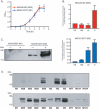Identification and characterization of an antigen I/II family protein produced by group A Streptococcus
- PMID: 16790795
- PMCID: PMC1489706
- DOI: 10.1128/IAI.00493-06
Identification and characterization of an antigen I/II family protein produced by group A Streptococcus
Abstract
Group A Streptococcus (GAS) is a gram-positive human bacterial pathogen that causes infections ranging in severity from pharyngitis to life-threatening invasive disease, such as necrotizing fasciitis. Serotype M28 strains are consistently isolated from invasive infections, particularly puerperal sepsis, a severe infection that occurs during or after childbirth. We recently sequenced the genome of a serotype M28 GAS strain and discovered a novel 37.4-kb foreign genetic element designated region of difference 2 (RD2). RD2 is similar in gene content and organization to genomic islands found in group B streptococci (GBS), the major cause of neonatal infections. RD2 encodes seven proteins with conventional gram-positive secretion signal sequences, six of which have not been characterized. Herein, we report that one of these six proteins (M28_Spy1325; Spy1325) is a member of the antigen I/II family of cell surface-anchored molecules produced by oral streptococci. PCR and DNA sequence analysis found that Spy1325 is very well conserved in GAS strains of distinct M protein serotypes. As assessed by real-time TaqMan quantitative PCR, the Spy1325 gene was expressed in vitro, and Spy1325 protein was present in culture supernatants and on the GAS cell surface. Western immunoblotting and enzyme-linked immunosorbent assays indicated that Spy1325 was produced by GAS in infected mice and humans. Importantly, the immunization of mice with recombinant Spy1325 fragments conferred protection against GAS-mediated mortality. Similar to other antigen I/II proteins, recombinant Spy1325 bound purified human salivary agglutinin glycoprotein. Spy1325 may represent a shared virulence factor among GAS, GBS, and oral streptococci.
Figures








Similar articles
-
Identification of new candidate vaccine antigens made by Streptococcus pyogenes: purification and characterization of 16 putative extracellular lipoproteins.J Infect Dis. 2004 Jan 1;189(1):79-89. doi: 10.1086/380491. Epub 2003 Dec 22. J Infect Dis. 2004. PMID: 14702157
-
A Mobile Genetic Element Promotes the Association Between Serotype M28 Group A Streptococcus Isolates and Cases of Puerperal Sepsis.J Infect Dis. 2019 Jul 31;220(5):882-891. doi: 10.1093/infdis/jiz195. J Infect Dis. 2019. PMID: 31107945 Free PMC article.
-
Characterization of a novel leucine-rich repeat protein antigen from group B streptococci that elicits protective immunity.Infect Immun. 2005 Mar;73(3):1671-83. doi: 10.1128/IAI.73.3.1671-1683.2005. Infect Immun. 2005. PMID: 15731068 Free PMC article.
-
Strategic development of the conserved region of the M protein and other candidates as vaccines to prevent infection with group A streptococci.Expert Rev Vaccines. 2015;14(11):1459-70. doi: 10.1586/14760584.2015.1081817. Expert Rev Vaccines. 2015. PMID: 26485214 Review.
-
Group A streptococcal vaccines: facts versus fantasy.Curr Opin Infect Dis. 2009 Dec;22(6):544-52. doi: 10.1097/QCO.0b013e328332bbfe. Curr Opin Infect Dis. 2009. PMID: 19797947 Review.
Cited by
-
Specific binding of a naturally occurring amyloidogenic fragment of Streptococcus mutans adhesin P1 to intact P1 on the cell surface characterized by solid state NMR spectroscopy.J Biomol NMR. 2016 Feb;64(2):153-64. doi: 10.1007/s10858-016-0017-1. Epub 2016 Feb 2. J Biomol NMR. 2016. PMID: 26837620 Free PMC article.
-
A naturally occurring single amino acid replacement in multiple gene regulator of group A Streptococcus significantly increases virulence.Am J Pathol. 2015 Feb;185(2):462-71. doi: 10.1016/j.ajpath.2014.10.018. Epub 2014 Dec 2. Am J Pathol. 2015. PMID: 25476528 Free PMC article.
-
The RD2 Pathogenicity Island Modifies the Disease Potential of the Group A Streptococcus.Infect Immun. 2021 Jul 15;89(8):e0072220. doi: 10.1128/IAI.00722-20. Epub 2021 Jul 15. Infect Immun. 2021. PMID: 33820819 Free PMC article.
-
Contribution of exogenous genetic elements to the group A Streptococcus metagenome.PLoS One. 2007 Aug 29;2(8):e800. doi: 10.1371/journal.pone.0000800. PLoS One. 2007. PMID: 17726530 Free PMC article.
-
Immunogenicity and prediction of epitopic region of antigen Ag I/II and glucosyltransferase from Streptococcus mutans.J Huazhong Univ Sci Technolog Med Sci. 2016 Jun;36(3):416-421. doi: 10.1007/s11596-016-1602-y. Epub 2016 Jul 5. J Huazhong Univ Sci Technolog Med Sci. 2016. PMID: 27376814
References
-
- Anonymous. 2005. Active bacterial core surveillance (ABCs) report: emerging infections program network group A Streptococcus, 2004—provisional. [Online.] http://www.cdc.gov/ncidod/dbmd/abcs/survreports/gas04prelim.htm.
-
- Banks, D. J., S. B. Beres, and J. M. Musser. 2005. The contribution of phages to group A Streptococcus genetic diversity and pathogenesis, p. 319-334. In M. K. Waldor, D. I. Friedman, and S. L. Adhya (ed.), Phages: their role in bacterial pathogenesis and biotechnology. ASM Press, Washington, D.C.
-
- Banks, D. J., S. F. Porcella, K. D. Barbian, S. B. Beres, L. E. Philips, J. M. Voyich, F. R. DeLeo, J. M. Martin, G. A. Somerville, and J. M. Musser. 2004. Progress toward characterization of the group A Streptococcus metagenome: complete genome sequence of a macrolide-resistant serotype M6 strain. J. Infect. Dis. 190:727-738. - PubMed
-
- Beres, S. B., G. L. Sylva, K. D. Barbian, B. Lei, J. S. Hoff, N. D. Mammarella, M. Y. Liu, J. C. Smoot, S. F. Porcella, L. D. Parkins, D. S. Campbell, T. M. Smith, J. K. McCormick, D. Y. Leung, P. M. Schlievert, and J. M. Musser. 2002. Genome sequence of a serotype M3 strain of group A Streptococcus: phage-encoded toxins, the high-virulence phenotype, and clone emergence. Proc. Natl. Acad. Sci. USA 99:10078-10083. - PMC - PubMed
MeSH terms
Substances
LinkOut - more resources
Full Text Sources
Other Literature Sources
Research Materials

